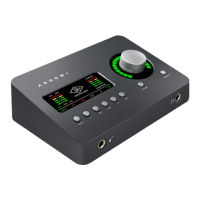Arrow Manual Console Overview 77
Channel Strips Overview
Each Console input channel strip (illustrated at right)
controls a corresponding Arrow input. The output of
all Console channel input strips are always routed to
Console’s monitor outputs (except when muted).
Console’s input channel strips are essentially the same for
all inputs, however there are some differences among the
analog and virtual inputs, as noted below.
Note: For detailed descriptions, see Channel Input
Controls.
Signal Flow
Audio signals in a Console channel flow through the
inserts serially from top to bottom. Therefore, if more
than one plug-in is inserted in a channel, the location of
a plug-in within the inserts can impact the sound of the
channel. Plug-ins can be reordered by dragging them to
change the serial processing order.
Input Types
Console has analog and virtual inputs. The controls that
are available in each strip depends on the type of input.
Preamp Inputs
Inputs 1 and 2 are analog preamp channels that have
multiple physical inputs (mic, line, Hi-Z) that can be
selected with the preamp controls.
The analog inputs are switched between mic and line
inputs manually via Console or Arrow’s top panel. Channel
1 is automatically switched to Hi-Z input when a ¼”
mono (tip-sleeve) cable is plugged into Arrow’s front panel
Hi-Z input jack.
Virtual Inputs
The virtual input channels do not control Arrow’s hardware
inputs. Instead, they receive digital signals from DAW
outputs via Arrow’s device drivers, enabling Realtime UAD
Processing on any DAW output. This feature is especially
useful when playing virtual software instruments live
through UAD plug-ins because it reduces I/O buffered
input latency. For complete details about this feature, see
Virtual I/O.
Preamp
Controls &
Unison Insert
Standard
Channel Plug-In
Inserts
Aux & Cue
Sends Display
Monitor Mix
Controls
Input
Label
Input channel strip

